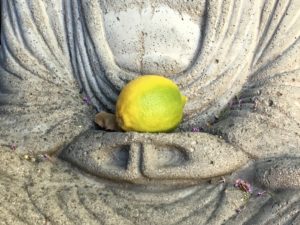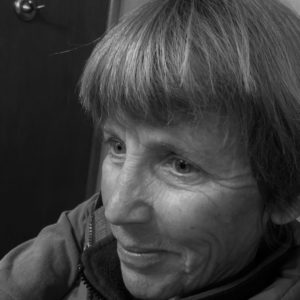 On this day, one year ago, I was on my way to spend the winter at a Zen Buddhist monastery in California. I have done this for many years. It is a recurring three months of my life that I spend in relative silence and contemplation, and although it is difficult and different and I have never tried to describe it as “an experience,” there is a great beauty to it that compels me to speak of it now.
On this day, one year ago, I was on my way to spend the winter at a Zen Buddhist monastery in California. I have done this for many years. It is a recurring three months of my life that I spend in relative silence and contemplation, and although it is difficult and different and I have never tried to describe it as “an experience,” there is a great beauty to it that compels me to speak of it now.
There is hardship as well. Not much sleep. Or food. And it is often not very peaceful. People tend to believe monastic life, especially Buddhist monastic life, is blissful. I’m sure I’m no authority on bliss, but aesthetically it can be pleasing to sit and work and eat and live simply.
It can also be devastatingly boring. And painful. Your knees complain, your back hurts, you think about things that remind you that you’re a flawed human being. Your view is of the wall in front of you. We sit for hours looking only at a wall. A certain relief—though I would not call it bliss—comes from surviving an experience such as this. Why do we do it? Why are we drawn to it? What is the learning here? Where is the joy in studying the self?
Ah, but there is music. Or rather, there are instruments. And order. We have bells, many bells, from the wake-up bell at 3:50 a.m. until the densho bell at 9 p.m. Each bell has a different timbre and carries a different message. “Wake up!” is different from “Goodnight,” and “Come to the meditation hall now” has an urgency that “Sit still for the next forty minutes” does not. Leonard Cohen’s insistent refrain was born in a monastery: “Ring the bells that still can ring/Forget your perfect offering/There is a crack in everything/That’s how the light gets in….”
We also have a drum, a very large drum which is played at meal time, because meals are a ceremony. It is played on other sober and jubilant occasions as well. It is a marvelous instrument to play, and it teaches as you go. It teaches the arms and wrists to relax and most importantly the mind. A tight mind cannot play this drum and its benevolence is in letting you know very quickly so the suffering is less.
And we have something called a han—a block of wood that hangs on the walkway encircling the meditation hall. The han speaks when struck with a wooden mallet, and its language is measured in a pattern of time-telling hits. The bells, the drum, the han—they speak in our silent times. A monastery is full of sound, but most of the sound is not human voices.
The instruments invite us. That’s what Leonard Cohen was getting at. The invitation is to allow our own silence to become the essence of mind. To make room for a transformation of thought. We bow to one another instead of speaking words. The act of bowing, the art of bowing, becomes a language of its own, a physical manifestation of respect. To stop on the path, to really stop and stand still for the time it takes to bow, gives us the opportunity to see our own compulsion to outrun life, to live ahead of ourselves, to not savor this very moment. The Japanese way can seem formal and restrained, but this outward formality allows for great inner freedom. This is not something you need to ponder, because words fail to convey it. It must be lived.
We all wear the same black robes, calf- or ankle-length and belted. We do this to remind ourselves of the interconnectedness of all things, the uniformity that Americans despise but Asians have learned to find useful. Individuality is not in question, but feeling oneself to be special, different or separate rarely leads to contentment and never, in the end, to happiness.
The monastery is situated beside a creek in a narrow valley known for its hot springs, near the Pacific coast. When the winter rains come, the creek rises and floods and the scratch of an access road collapses, often stranding us. The larder gets thin, as do the monks, and when the hot springs are flooded the geothermal heat fails and we shiver. Last winter I stood and watched in awe as a sturdy footbridge crossing the creek was swept away, its planks and cables cartwheeling downstream like a ship under sail. The booming of mudslides often interrupts morning and evening meditation, and the creek itself is deafening, a constant presence of water in motion. The thoughts follow or resent it, are soothed or disturbed by it. The rain, too, becomes an insistent instrument sounding on the metal roof of the meditation hall.
So why do we do it? Where is the joy, the compelling beauty? Much of it is visual, sensual. Lamplight falling on the faces of 60 monks lined up on the walkway at dusk, preparing to enter the meditation hall. The wooden walkway itself, polished smooth by the traffic of human feet. The words inscribed on the han, meant to urge us on in our practice: Awake! Awake! Your life is almost gone! Do not pass your days and nights in vain! First light on the mountains. First snow. Steam rising from the hot springs and the pleasurable plunge into liquid warmth. Two condors sliding high across the sky and the cry of red-tails as spring arrives. Wisteria in near-bloom. The soft light of oil lamps on the altar. The rain’s softening and departure. 108 resonant hits of the densho bell filling the valley to acknowledge the passing of a life.
And there’s this: To study the way is to study the self, we are told. In the monastery, minus the commitments and distractions of our ordinary lives, the self has a little more room to come forward, to be seen. Its habits and responses become more familiar, as well as its ever-changing nature. The familiar self is also the elusive self, the ephemeral self, a disappearing shadow created over and over again like the vibration of a rung bell.

